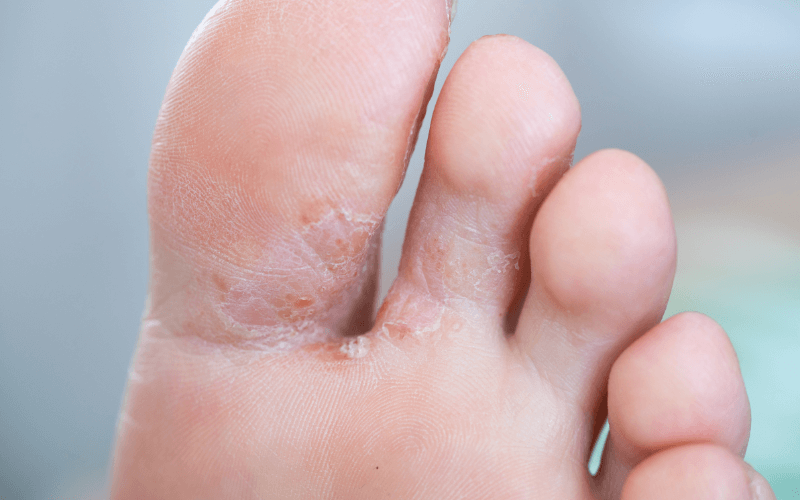Athlete’s foot is often recognised by its classic symptom: itchy skin between the toes. However, many people are unaware of the full spectrum of symptoms, causes, and potential complications associated with this common foot condition. Whether you’re an athlete or not, athlete’s foot can be a frustrating problem that affects your daily life. In this comprehensive guide, we’ll explore everything you need to know, including how to treat it and prevent it from recurring.
What Is Athlete’s Foot?
Athlete’s foot, also known as tinea pedis, is a fungal infection that primarily affects the skin on your feet, particularly the areas between your toes. The condition typically starts between the smallest toes, where moisture tends to accumulate, providing an ideal environment for fungal growth. If left untreated, the infection can spread to other areas of the feet, including the heels, soles, and even the toenails.
What Causes the Infection?
Athlete’s foot is caused by a variety of fungi from the Epidermophyton, Microsporum, and Trichophyton families. These fungi thrive in warm, moist, and dark environments, which is why the condition is often associated with sweaty feet or wearing tight, non-breathable shoes. While athletes are particularly susceptible due to their active lifestyles and frequent use of communal showers, anyone can be infected.
How Common Is It?
According to PubMed, about 15% of the general population in the UK has athlete’s foot, or tinea pedis. This means that around 1.2 million people in the UK have fungally infected toenails right now.
It’s one of the most common conditions we treat at our London chiropody clinics.
What Are the Symptoms?
Symptoms range from mildly irritating to extremely uncomfortable and typically include:
- Itchiness: Particularly between the toes
- Redness and Inflammation: The skin may appear red, swollen, and irritated
- Scaly or Peeling Skin: The skin may flake off or peel away
- White, Moist Areas: Particularly between the toes
- Blisters: These can be painful and prone to infection
Over time, the infected skin may become dry and cracked, leading to painful fissures. If untreated, the infection can also spread to the toenails, causing fungal nail infections, and even to other parts of the body.
How Does it Spread?
Athlete’s foot is highly contagious and spreads through direct contact with infected skin or through contaminated surfaces such as shower floors, locker rooms, and even household items like towels and bath mats. The infection can easily pass between family members, particularly if hygiene practices are not strictly followed.
Can It Be Prevented?
While athlete’s foot is highly infectious, there are steps you can take to reduce your risk:
- Keep Feet Clean and Dry: Wash your feet daily and dry them thoroughly, especially between the toes.
- Change Socks Regularly: Wear clean socks every day and avoid reusing socks without washing them.
- Choose Breathable Footwear: Opt for shoes made of natural materials that allow your feet to breathe.
- Avoid Walking Barefoot in Communal Areas: Always wear flip-flops or shower shoes in public showers and locker rooms.
- Use Antifungal Powder or Spray: These products can help keep your feet dry and reduce the risk of fungal growth.
What Treatment Is Available?
Treating athlete’s foot typically involves the use of antifungal medication, which are available in several forms:
- Topical Treatments: Creams, sprays, or powders applied directly to the affected area are the most common treatments for mild to moderate cases.
- Oral Antifungal Medication: In more severe cases, oral medications may be prescribed, although they are not suitable for everyone.
- Surgical Spirit: Applying surgical spirit between the toes can help to dry out the skin and has antiseptic properties that may assist in the healing process.
Expert Treatment in London
Athlete’s foot is a common but manageable condition. By understanding its causes, symptoms, and treatment options, you can take steps to protect your feet and prevent the infection from spreading or recurring. If you suspect you have athlete’s foot, don’t ignore the signs – early treatment is key to a quick recovery.
At Feet By Pody, our team of experienced chiropodists and podiatrists are well-equipped to diagnose and treat athlete’s foot effectively. We offer personalised treatment plans that address your specific needs, ensuring that the infection is eliminated and reducing the risk of recurrence. We also provide advice on how to care for your feet to prevent future infections.
Call Feet By Pody today on 0207 099 6657 or book an appointment online.

